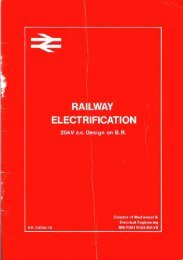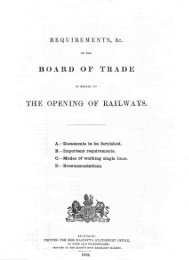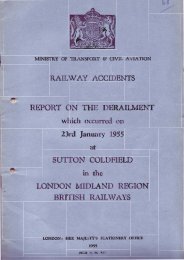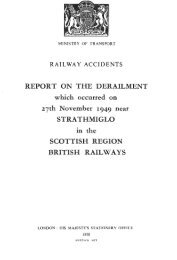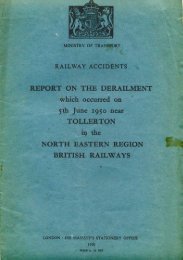R A I LT R AC K - The Railways Archive
R A I LT R AC K - The Railways Archive
R A I LT R AC K - The Railways Archive
Create successful ePaper yourself
Turn your PDF publications into a flip-book with our unique Google optimized e-Paper software.
Route characteristics<br />
DESCRIPTION <strong>The</strong> route has two main elements. First, the line from London<br />
Waterloo to Reading via Staines, which is primarily a suburban commuter route,<br />
with little variation in stopping patterns and train speeds. Second, the North<br />
Downs Line connecting Reading, Guildford and the Brighton Main Line at Redhill.<br />
This line, despite being less busy, has a greater mix of traffic types, as it is used by<br />
freight and longer-distance passenger services.<br />
<strong>The</strong> route is predominantly two track, the only four-track section being<br />
between Clapham Junction and Barnes. <strong>The</strong>re are short sections of single line on<br />
the approaches to Reading and between Frimley and Ash Vale. <strong>The</strong>re are two<br />
non-electrified sections of the North Downs Line; these are<br />
Wokingham–Aldershot South Junction and Shalford Junction–Reigate.<br />
Route vision<br />
To capture a greater market share to Heathrow while improving suburban, orbital<br />
and cross-country services. In the short term, we have entered into a<br />
partnership with SWT, London Transport, BAA and the London Borough of<br />
Hillingdon to open a new rail–bus interchange at Feltham Station. This will open<br />
in the second quarter of this year. Feltham Station will then become a coordinated<br />
and timetabled interchange with direct bus links into Heathrow<br />
Airport. In the longer term, we see an opportunity for a rail link into Heathrow<br />
Airport from the southern direction and will work with the major industry<br />
players such as BAA, train operators and local authorities on the development of<br />
a proposal for a scheme named Airtrack. <strong>The</strong> Airtrack concept will give access to<br />
Route development and customer requirements<br />
Quality of service is important to us and our customers and so we are helping<br />
them to introduce new rolling stock on the route. This will also provide<br />
opportunities to improve journey times to Reading and improve the<br />
attractiveness of the route.<br />
Although this route has not been identified as a bottleneck, we have been<br />
working with SWT on a capacity study which includes Waterloo–Barnes. <strong>The</strong><br />
aim of the study is to develop potential solutions to overcrowding on trains<br />
approaching Waterloo. <strong>The</strong> route is operating close to capacity during peak<br />
times and any immediate solutions found to ease this will be announced before<br />
the next NMS. We recognise that, if Feltham Gateway and Airtrack are<br />
successful in improving rail’s market share, capacity improvements will be<br />
required. Solutions to these could be higher density rolling stock and longer<br />
trains, coupled with a platform extension programme, but in the longer term<br />
expensive infrastructure solutions will have to be found. We are working on a<br />
strategy so that we can offer options to potential funders.<br />
<strong>The</strong> orbital line from Reading to Guildford and Redhill is a key strategic link<br />
for Thames Trains’ services between Oxford, Reading and Gatwick Airport, and<br />
for Virgin Trains’ services between the Midlands, the North and Portsmouth.<br />
Our vision is to improve the attractiveness of the line to encourage a significant<br />
increase in rail’s share of traffic from the Reading–Guildford Corridor to Gatwick<br />
Airport. We also expect further growth in passenger numbers on commuter<br />
services into Reading and Guildford and the route is under consideration for a<br />
potential gauge enhancement scheme which may result in increased freight usage<br />
of the line.<br />
While the present infrastructure is adequate for the current level of service,<br />
key pinchpoints are track and platform capacity at Reading and signal spacing<br />
between Wokingham and North Camp. We will undertake a study in<br />
conjunction with our customers to identify the level of enhancement needed to<br />
cope with projected growth.<br />
We are working with Thames Trains to identify a package of linespeed<br />
improvements to reduce the journey time between Reading and Gatwick<br />
Airport. Initially, we will identify incremental improvements which can be achieved<br />
in the short term. We will also examine further, major work which would be<br />
required to achieve Thames Trains’ aspiration of a one-hour journey time<br />
between Reading and Gatwick Airport.<br />
Other suburban routes branch off the core route at Barnes for the Hounslow<br />
Loop, at Twickenham for links to Shepperton and Kingston, at Staines for<br />
Windsor, Virginia Water for Weybridge and at Ascot for Ash Vale.<br />
<strong>The</strong> linespeed between Clapham Junction and Feltham and on some of the<br />
branch lines is 60mph. To the west of Feltham and on the North Downs Line,<br />
the predominant linespeed is 70mph.<br />
<strong>The</strong> suburban stations are capable of accepting eight-vehicle trains and this,<br />
together with the limiting capacity of the line to Waterloo, reduces the shortterm<br />
options to reduce overcrowding on trains at peak times.<br />
Heathrow Airport from Staines, on the Windsor & Eton Riverside Route. It<br />
could also provide new journey opportunities from this route to other parts of<br />
the national network.<br />
Although this route is essentially a suburban railway, we believe there is a<br />
demand for a faster journey time to Reading from Waterloo in order to make<br />
this route more competitive. This will also be important if, or when, the Airtrack<br />
development is completed. We recognise that there are some significant<br />
difficulties in achieving this but are looking at economical ways to deliver the<br />
industry vision.<br />
Train performance is an area that we and our customers take very seriously. We<br />
are therefore developing a strategy that will see a rapid and steady reduction in<br />
infrastructure failures on the core of the route between Waterloo and Barnes.<br />
We anticipate that this improvement will be tangible by the next NMS. This will<br />
be achieved through enhanced maintenance and targeted renewals of<br />
infrastructure. Together with our maintenance contractors, we have developed<br />
teams of specialists who target persistent infrastructure failures until they are<br />
eliminated. We see this as essential to drive down train delays and improve train<br />
punctuality. We are also working with our customers on initiatives that will yield<br />
performance improvements through train timetabling and contingency planning.<br />
Improving train punctuality when the number of trains running on our<br />
network has increased substantially is an enormous task. Wo rking with tra i n<br />
o p e ra t o rs, we will improve charter punctuality by two percentage points over the<br />
next two ye a rs. This improvement, which will vary across service groups, will<br />
t y p i c a l ly result in 16% fe wer trains arriving at their destinations more than fi ve<br />
m i nutes late.<br />
We recognise that, as demand increases, we will have to address depot<br />
capacity and location and have started working with our customers on a depot<br />
strategy that will enable us to make incremental improvements to the depots as<br />
demand increases.<br />
We intend to work with customers to improve the attractiveness of<br />
stations through completion of the regeneration programme and will be<br />
renewing existing customer-information systems on South West Trains’ operating<br />
area over the next two years.<br />
In partnership with SWE<strong>LT</strong>R<strong>AC</strong>, we are working to deliver environmental<br />
improvements to various stations in South West London. We are also working<br />
with the Rugby Football Union to seek improvements at Twickenham Station to<br />
accommodate passengers attending events at the Twickenham ground.<br />
We recognise that increased demand for passenger services also requires<br />
more car-parking capacity. We are working with our customers to identify<br />
locations where improvements in car-parking facilities can and should be made,<br />
including facilities to cater for off-peak demand. In conjunction with South West<br />
Trains, we are currently exploring a car-park extension at Egham.<br />
251



